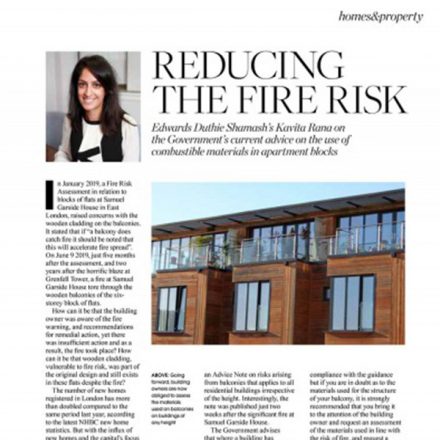Reducing the Fire Risk in Apartment Blocks
“The fire which destroyed Grenfell Tower in June 2017 was one of the UK’s worst modern disasters.” (BBC, 18th June 2018).
In January 2019, a Fire Risk Assessment in relation to blocks of flats built by Bellway Homes at Samuel Garside House in East London, raised concerns with the wooden cladding on the balconies. It stated that if “a balcony does catch fire it should be noted that this will accelerate fire spread…”
On 9th June 2019, just five months after the Assessment, and one year after the horrific blaze in Grenfell Tower, yet another block of flats in London was engulfed in flames. This fire at Samuel Garside House tore through the wooden balconies of the six-storey block of flats. Eight flats were destroyed with damage to the remaining flats. Three months after the fire, many residents still remain in temporary accommodation, moving from hotel rooms to unfurnished apartments. Residents remain traumatised.
How can it be that the building owner was aware of the fire warning, and recommendations for remedial action, yet there was insufficient action and as a result, the fire took place? How can it be that wooden cladding, vulnerable to fire risk, was part of the original design and still exists in these flats despite the fire?
The number of new homes registered in London has more than doubled compared to the same period last year, according to the latest NHBC new home statistics. More than 7,000 new homes were registered in the capital between March and May this year, a 125 per cent increase on 2018. In the month of May alone, more than 16,000 new homes were registered to be built across the UK – 11 per cent more than a year ago.
With the influx of new homes being built and registered, and the capital’s focus on apartment blocks, balconies and decorative appearance, what does this mean for the future in respect of materials used on apartment blocks and balconies?
The Government’s previous advice of December 2018 was that buildings standing more than 18 metres tall are classed as high rise and so are subject to more stringent restriction on the type of cladding they can use. There was opposition and questions raised as to why there was no control for buildings below the 18 metres threshold, and why there was no requirement for developers to use materials with limited combustibility for buildings under 18m.
The good news is that on 24th June 2019, the Ministry of Housing, Communities & Local Government published an Advice Note on risks arising from balconies, written for residents and building owners of flats, although the principles may apply to other building types. Most importantly, the Note applies to all residential buildings irrespective of the height of the building. Interestingly, the Note was published just two weeks after the significant fire at Samuel Garside House. Inevitably the informed opinion is that the Advice Note was a direct response to this fire.
The Government advises that where a building has balconies which are constructed of combustible materials, “the clearest way to prevent the risk of external fire spread is to remove and replace any combustible material with one that is non-combustible…”. This is progress is monumental but not yet a legal requirement. The most recent guidance imposes more stringent requirements on buildings irrespective of height.
Going forward, building owners are now obliged to assess the materials used on balconies on buildings of any height, and determine whether they are combustible materials, or impose risk of fire. The onus is on the building owner to take action to manage and eliminate the risk.
If you are a tenant and/or a member of a Residents Association you should be considering your position if the block where you live is covered by wooden cladding or other cladding susceptible to fire. You should be looking to see how your Landlord can be compelled to remedy this potentially serious problem that could be putting you at risk.
It is not yet clear what steps the Government will take to enforce compliance with the guidance but if you are in doubt as to the materials used for the structure of your balcony, it is strongly recommended that you bring it to the attention of the building owner and request an assessment of the materials used in line with the risk of fire, and request a report on the findings, particularly given the most recent guidance of the Government.
If you are the flat owner then you will need to consider your lease in line with your own responsibilities to solve this serious problem. You will need to determine your own responsibility as against any Freeholder. If you are the flat owner then you need to be aware that the issue of cladding might affect your service charges payment. It might impact upon your right to re-mortgage your home, or affect your insurance policy. This problem could affect the value of your home, which is probably the most important investment you have ever made. It maybe that you have other remedies available to you. What representations were made to you by the Vendor, at the time you committed to your purchase, as to the safety of your building and the issue of a fire risk? How adequate was your survey? Did it address this important issue? These investigations could provide you with a remedy for this potentially serious problem.
If you have any doubt about any of these issues you should seek independent legal advice.
